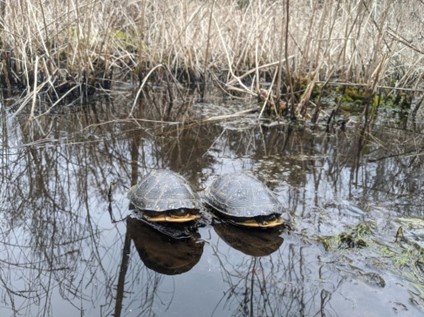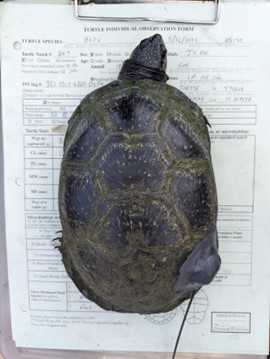This year we have continued our efforts of trapping for headstarts at Great Meadows. However, our goal has shifted in the target headstarts we are hoping to capture this field season. Last year we had been focusing on all headstarts, but particularly younger juveniles in shrubbier and harder to reach areas. This year we are aiming to catch more of the older headstarts. We have moved our traps to more open water and cattail edges where adults and older juveniles would more likely be found. So far it has been a very successful trapping effort; we’ve captured 17 adult and 21 headstarted juvenile Blanding’s turtles, mostly the older juveniles we hoped for.
We are continuing our trapping efforts now and we’re hoping to catch even more older juvenile headstarts. Part of our goals with this trapping session has also been to attach radios to some of these older headstarts to gather more data on their movements and habitat use; we have much more of this data for our younger headstarts.

Among our captures this year was one of the original 10 headstarted turtles from Great Meadows! These turtles were part of a pilot program in 2003 to determine if headstarting was feasible for Blanding’s turtles to be re-released into the wild. The headstarting of the turtles went well. However, upon release of the turtles the water levels dropped and 5 of the original 10 did not make it through their first winter. The remaining turtles were tracked until their radios expired and, prior to this year, we had only found 1 of those 5 survivors of our first headstarting trial.
In late May of this year, we captured an older juvenile headstart notched #20, who is very likely another of the original headstarting cohort from 2003. We are almost certain of his identity, but we’ve learned that identifying turtles that were marked with carapace notches as small juveniles can be challenging if they are not seen for many years, as was the case with #20.

That is why now we are also using pit tags in many of our turtles as an added means of identification. These small pit tags are like a microchip you could put in your dog or cat. He now has one of these unique pit tags so we can ID him in the future with certainty. We also decided to put a radio on him to monitor his movements and learn more about where he goes throughout the year and what habitat he uses. He is not the only older headstart, either; we have also caught one headstarted juvenile Blanding’s turtle from 2007, one from 2008, six from 2009, five from 2010, and two from 2011. We have put radios on some of these other headstarts and we’re hoping to learn more about them from being able to track each of them over the course of the year. It has been an exciting field season thus far at Great Meadows, with lots more good things to come as we await the hatching of our recently-protected nests!
